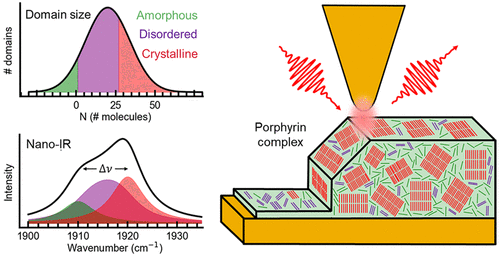Vibrational coupling infrared nanocrystallography
| REVIEWS AND HIGHLIGHTS | QUANTUM SCIENCE | MOLECULAR AND SOFT-MATTER | ULTRAFAST NANO-OPTICS AND NANOPHOTONICS | MINERALOGY AND GEOCHEMISTRY |
|---|
Richard L. Puro, Thomas P. Gray, Tsitsi A. Kapfunde, George B. Richter-Addo, and Markus B. Raschke
Nano Lett. 24, 1909 (2024).
DOI PDF SI

Coupling between molecular vibrations leads to collective vibrational states with spectral features sensitive to local molecular order. This provides spectroscopic access to the low-frequency intermolecular energy landscape. In its nanospectroscopic implementation, this technique of vibrational coupling nanocrystallography (VCNC) offers information on molecular disorder and domain formation with nanometer spatial resolution. However, deriving local molecular order relies on prior knowledge of the transition dipole magnitude and crystal structure of the underlying ordered phase. Here we develop a quantitative model for VCNC by relating nano-FTIR collective vibrational spectra to the molecular crystal structure from X-ray crystallography. We experimentally validate our approach at the example of a metal organic porphyrin complex with a carbonyl ligand as the probe vibration. This framework establishes VCNC as a powerful tool for measuring low-energy molecular interactions, wave function delocalization, nanoscale disorder, and domain formation in a wide range of molecular systems.
